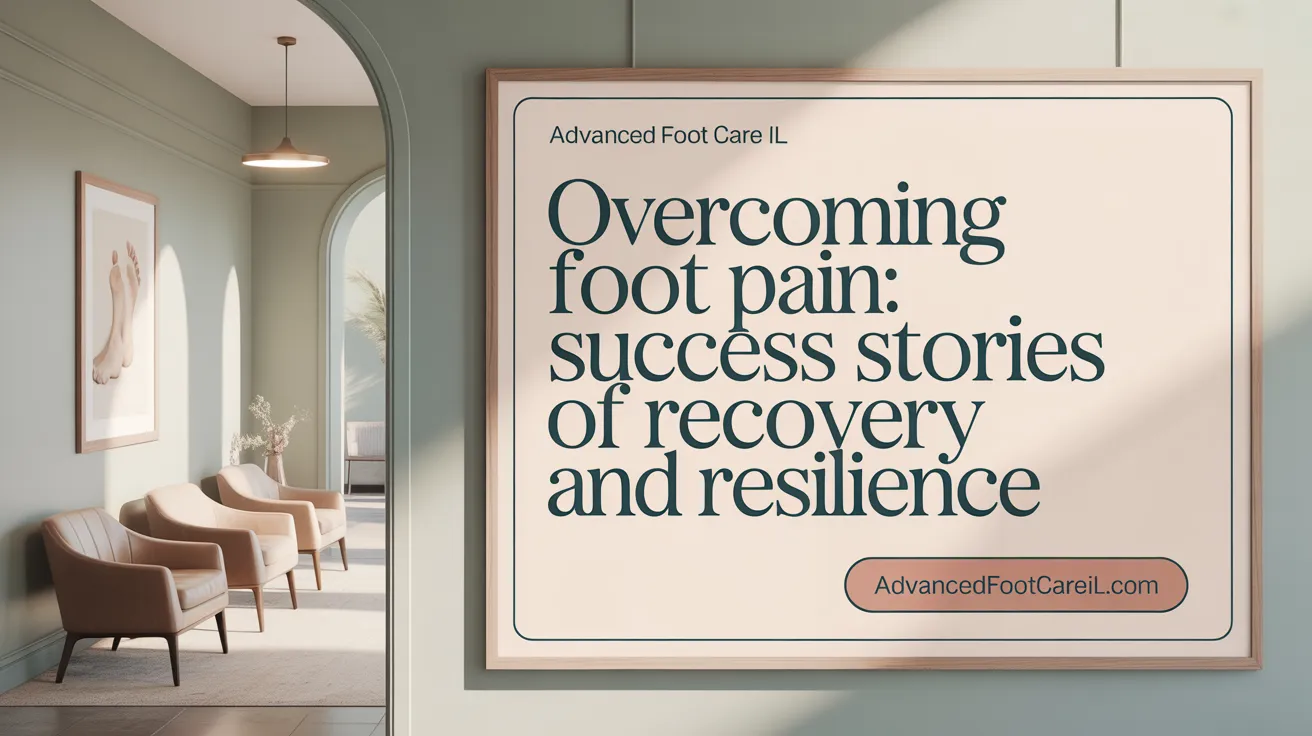The Journey From Pain to Progress
Foot pain and deformities can drastically impact daily life, mobility, and overall well-being. Thanks to advances in podiatric medicine and therapies, patients worldwide are sharing inspiring success stories of recovery—from overcoming plantar fasciitis and bunions to complex diabetic foot issues and congenital deformities like clubfoot. This article explores real-life journeys of healing through modern treatments and highlights the innovations and dedicated care transforming foot health today.
Personal Triumphs Over Common Foot Conditions

What are some examples of successful recovery from common foot conditions?
Many have triumphed over foot conditions like Plantar Fasciitis Treatment and Managing Bunions Without Surgery by following tailored treatment plans. For instance, Sarah, a 45-year-old teacher, endured plantar fasciitis for over a year but found relief after physical therapy, custom orthotics, and regular stretching exercises. Her consistent efforts allowed her to walk comfortably again, regaining daily mobility.
Similarly, Tom, a keen runner in his 30s, faced bunion pain caused by narrow footwear. Instead of surgery, he switched to wider shoes, used protective pads, and engaged in specific exercises, which effectively reduced his pain and helped him avoid invasive procedures.
How important is self-care and professional guidance in foot pain recovery?
The combination of expert care and personal commitment is essential in managing foot pain. Importance of Professional Guidance from podiatrists and physical therapists provides crucial professional guidance that ensures treatment plans are personalized for each patient's needs, leading to faster recovery and reduced risk of complications.
Equally important is Self-Care for Foot Health. Patients must listen attentively to their bodies and practice supportive habits such as wearing proper footwear and performing recommended foot exercises regularly. This dual approach enhances healing and fosters long-term foot health.
Why is patient engagement critical in recovery?
Active participation by patients in their treatment process can accelerate healing. Following therapy regimens, using orthotic devices, and maintaining lifestyle adjustments reflect engagement that often results in successful outcomes. Support Communities for Foot Pain and sharing experiences can also provide motivation and encouragement throughout recovery.
Together, professional care and diligent self-care make complex foot conditions manageable and allow many to return to active, pain-free lives.
Advanced Surgical and Non-Surgical Interventions Changing Lives

What modern surgical and non-surgical treatments are proving effective for foot conditions?
Foot care has benefited greatly from both surgical and non-surgical innovations. Minimally invasive surgeries for bunions and ankle disorders allow for precise corrections with smaller incisions, leading to faster recovery times and less postoperative pain. Alongside surgery, technologies such as laser therapy for toenail fungus treat fungal toenails safely and effectively, reducing infection without extensive downtime. Shockwave therapy harnesses sound waves to promote tissue repair, especially useful in chronic heel pain (plantar fasciitis).
Regenerative medicine is another advancing frontier, with platelet-rich plasma (PRP) injections and stem cell therapies aiding healing of tendon injuries and post-surgical inflammation. These treatments use the body's own healing factors to accelerate recovery. Combining these methods with personalized treatment plans crafted by podiatrists ensures that each patient receives the most appropriate care for their condition (Innovative foot doctor techniques).
Can you provide examples of patients benefiting from these advanced treatments?
Several patient stories demonstrate the success of these advanced interventions. Mary Alice Simpson, a 71-year-old patient, underwent a complex midfoot fusion with deformity correction, benefiting from a pain-free surgery experience and a well-supported recovery involving physical therapy. Meanwhile, Cherylyn Rogers faced multiple chronic foot deformities. Through carefully planned multiple surgeries, including bone grafting, she achieved significant pain relief and regained mobility.
Patients treated with MLS Laser and SoftWave therapies at various clinics reported returning to active lifestyles and competitive sports, underscoring the effectiveness of these minimally invasive and regenerative treatments. These personalized approaches not only alleviate pain but also restore function, improving quality of life for many individuals with chronic foot disorders (Foot and Ankle Success Stories).
Together, these advances mark a transformative era in podiatry, combining surgical precision with innovative healing technologies to change the lives of patients facing complex foot conditions.
Innovations in Diabetic Foot Care and Wound Management

How are modern technologies improving diabetic foot care outcomes?
Managing diabetic foot health has been revolutionized by advanced technologies like the Podimetrics SmartMat™ developed by Podimetrics. This device integrates clinical intelligence with remote monitoring and personalized support, allowing early detection of foot ulcers in diabetic patients. Early intervention facilitated by this technology significantly reduces the likelihood of amputations and hospital stays, improving long-term patient outcomes and reducing healthcare costs.
What are some effective therapies for chronic diabetic foot wounds?
Chronic diabetic foot wounds can be challenging to treat, but several innovative therapies have shown promise. These include:
- Topical Oxygen Therapies (TOT): Devices that supply continuous or cyclic oxygen to wound sites, enhancing healing rates.
- Negative Pressure Wound Therapy (NPWT): This technique promotes granulation tissue formation and faster wound closure.
- Platelet and Fibrin Patches: Autologous patches provide growth factors for tissue repair.
- Hyperbaric Oxygen Therapy (HBOT): Helps neovascularization and reduces amputations, especially in difficult cases.
Details about these treatments can be found in evidence-based therapies for diabetic foot ulcers.
Importance of daily foot care and professional monitoring
Daily foot care is critical for people living with diabetes. Regular inspection for signs like redness, swelling, or wounds helps in early recognition of potential issues. Incorporating proper foot hygiene, wearing well-fitting shoes, and avoiding barefoot walking reduces injury risks. Professional annual foot exams by podiatrists are essential to identify early complications like neuropathy or poor circulation, guiding timely interventions. For more information, see Diabetes foot care and Tips for Healthy Feet.
Reducing amputations through technology and care
Integration of cutting-edge monitoring systems with evidence-based wound therapies has markedly decreased lower extremity amputations among diabetic patients. Collaboration among payors, providers, and patients, supported by devices such as the Podimetrics SmartMat™, helps optimize care delivery, ensuring early detection and management of diabetic foot complications, ultimately preserving limb function and enhancing quality of life.
Success Stories Highlighting Comprehensive Physical Therapy and Rehabilitation
How does physical therapy contribute to foot and ankle recovery?
Physical therapy is essential in treating ankle injuries and various foot conditions. It focuses on strengthening muscles, enhancing joint mobility, and reducing pain. For ailments such as ankle sprains, Achilles tendonitis, and post-operative recoveries, physical therapy helps restore functionality and stability. Patients often regain their ability to perform daily activities and return to sports, benefiting from tailored exercise plans and expert guidance. See more about Physical Therapy for Ankle Fractures.
What patient experiences demonstrate the impact of rehabilitation?
Patients frequently share inspiring stories of recovery where physical therapy played a pivotal role. For instance, individuals recovering from ankle fractures or foot surgeries report marked improvements in mobility, balance, and pain relief. An enhanced quality of life is commonly noted, enabling return to active lifestyles. Moreover, emotional and motivational support, including community encouragement and celebration of progress, is fundamental to sustaining rehabilitation efforts and achieving long-term success. Explore Foot and Ankle Patient Stories and Patient success stories on foot and ankle recovery.
The role of multidisciplinary care teams
Successful rehabilitation usually involves a team approach. Multidisciplinary care teams—including podiatrists, physical therapists, and surgeons—collaborate to create comprehensive recovery plans. Their joint efforts ensure that treatments are personalized, addressing both physical and psychological aspects of healing. Learn about Innovative foot doctor techniques and Contemporary Foot and Ankle Clinic.
Rehabilitation enabling return to sports and daily activities
Through structured rehabilitation, many patients resume sports and regular routines with renewed confidence. Physical therapy not only targets healing but also improves strength and endurance, essential for preventing future injuries and maintaining active lifestyles. Check out Foot and Ankle Success Stories and Successful foot surgery recoveries.
Emotional and motivational aspects of recovery
Recovery is as much an emotional journey as a physical one. Support networks, from clinical teams to peer groups, provide encouragement and share success stories. Celebrating small victories helps maintain motivation and resilience throughout the healing process. Read more about Recovery Journeys from Foot Pain and Support Communities for Foot Pain.
Transforming Congenital and Complex Foot Deformities Through Early and Expert Care
What treatments and outcomes are available for congenital deformities like clubfoot?
Clubfoot, also called talipes equinovarus, is a common congenital deformity where the foot turns inward. The Ponseti method is the leading treatment, involving gentle weekly casting to gradually reposition the foot and a minor procedure called Achilles tendon lengthening if needed.
This approach allows most children to gain normal foot function with minimal pain. After casting, bracing with specialized shoes and bars is critical to maintain correction and prevent recurrence. Compliance with these braces is essential for long-term success.
How do early interventions affect long-term mobility and lifestyle?
Early treatment of clubfoot, ideally within the first weeks of life, significantly improves outcomes. Children treated early often grow up walking, running, and playing sports without restrictions or pain.
Success stories from organizations like MiracleFeet highlight how these interventions transform children's lives. Many treated children enjoy activities like dancing, biking, and sports, markedly improving their social participation and quality of life.
Moreover, early expert care reduces the need for extensive surgery later. However, severe deformities or cases unresponsive to conservative treatment may require surgical management such as tendon lengthening or bone repositioning.
Impact on quality of life and social participation
Proper management of clubfoot and other complex deformities restores mobility and independence for affected children. Patients often report enhanced ability to participate fully in daily activities and social settings.
Early and sustained intervention not only corrects physical deformities but also supports normal lifestyle integration, reducing the emotional and physical burdens on families and patients alike.
Hope, Healing, and the Future of Foot Care
Modern foot treatments, ranging from conservative therapies to cutting-edge surgeries and innovative technologies, are reshaping patient outcomes and quality of life. The inspiring stories of those who have overcome pain, deformities, and chronic conditions exemplify the vital role of expert care, patient engagement, and ongoing advances in podiatry medicine. As new technologies emerge and treatment approaches evolve, even more patients will find pathways to relief, mobility, and renewed confidence in their journey toward better foot health.
